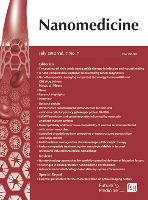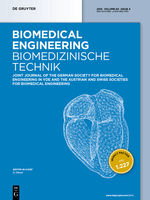
Bioengineering & Translational Medicine
Scope & Guideline
Advancing Biomedical Discoveries for Better Health
Introduction
Aims and Scopes
- Tissue Engineering and Regenerative Medicine:
Research focused on developing biomaterials and scaffolds that support tissue regeneration and healing, including innovations in 3D bioprinting and cell-laden hydrogels. - Nanotechnology in Medicine:
Exploration of nanomaterials for drug delivery, imaging, and therapeutic applications, including the design and optimization of nanoparticles and nanocarriers. - Immunotherapy and Cancer Treatment:
Studies on the use of engineered immune cells, such as CAR T-cells and dendritic cells, along with novel adjuvants and delivery systems for enhancing cancer immunotherapy. - Biomaterials and Biocompatibility:
Focus on the development and assessment of new biomaterials that are biocompatible and can be used in various medical applications, including implants and drug delivery systems. - Regenerative and Personalized Medicine:
Research aimed at understanding and utilizing stem cells and other regenerative therapies for personalized treatment approaches in various diseases. - Medical Imaging and Diagnostic Technologies:
Advancements in imaging techniques and biosensors for improved diagnostics and monitoring of diseases, including point-of-care devices. - Mechanobiology and Bioengineering:
Investigation of how mechanical forces and properties of biomaterials affect cellular behavior and tissue development, contributing to better design of therapeutic strategies.
Trending and Emerging
- CRISPR and Gene Editing Technologies:
A surge in research utilizing CRISPR technology for gene editing and therapeutic applications, reflecting its potential to revolutionize treatment strategies for genetic disorders and cancers. - Point-of-Care Diagnostics:
Increasing focus on developing portable and rapid diagnostic tools that enable immediate clinical decisions, particularly in infectious diseases and chronic conditions. - Artificial Intelligence and Machine Learning in Medicine:
Emerging applications of AI and machine learning for data analysis, predictive modeling, and enhancing diagnostic accuracy, showcasing the integration of computational techniques in biomedical research. - Sustainable and Biodegradable Materials:
A growing interest in developing environmentally friendly materials for medical applications, emphasizing sustainability in bioengineering practices. - Microfluidics and Organ-on-a-Chip Technologies:
Rising research on microfluidic devices and organ-on-a-chip systems as powerful tools for drug testing, disease modeling, and personalized medicine. - Immunogenicity and Vaccine Development:
A heightened emphasis on vaccine development and immunogenic responses, particularly in the context of emerging infectious diseases and cancer immunotherapy.
Declining or Waning
- Traditional Pharmacology and Small Molecule Drugs:
Research on conventional small molecule drugs appears to be decreasing as interest shifts towards biologics, gene therapies, and nanomedicine, which offer more targeted and effective treatment options. - Invasive Surgical Techniques:
There is a noticeable decline in studies focused on invasive surgical procedures, as the field moves towards less invasive, bioengineering-based approaches such as tissue engineering and regenerative medicine. - Basic Laboratory Studies without Clinical Relevance:
Papers that focus solely on basic laboratory research without a clear translational or clinical pathway are becoming less common, as there is a growing focus on studies that directly contribute to clinical applications. - Conventional Imaging Techniques:
Research on traditional imaging methods is waning, with a shift towards more advanced, integrated imaging technologies that combine diagnostics and therapeutic monitoring.
Similar Journals

Nanomedicine
Empowering Researchers with Groundbreaking Nanomedical DiscoveriesNanomedicine, published by Future Medicine Ltd, is a premier academic journal dedicated to the rapidly evolving field of nanotechnology in medicine. With an emphasis on innovative research and applications, this journal encompasses a broad spectrum of topics including bioengineering, biomedical engineering, and nanoscience, among others. Featuring an impressive Q1 ranking in Development and multiple Q2 rankings across significant categories, it serves as a pivotal resource for researchers and professionals aiming to stay at the forefront of advancements in these disciplines. While the journal is not open access, it is accessible through various institutional subscriptions, ensuring wide dissemination of cutting-edge findings. Notably, it has achieved substantial impact within the scientific community, indicated by its high rankings in Scopus and overall commitment to enhancing the understanding and application of nanomedicine. This journal is a vital conduit for fostering collaborations and innovations that transcend traditional medical paradigms.

Bioengineering-Basel
Unlocking Potential in Bioengineering ResearchBioengineering-Basel, an esteemed journal published by MDPI, stands at the forefront of innovation in the field of bioengineering since its inception in 2014. With an E-ISSN of 2306-5354, this fully Open Access journal based in Switzerland provides a platform for researchers and professionals to disseminate cutting-edge findings across various aspects of bioengineering, including biomaterials, tissue engineering, and biopharmaceuticals. The journal has been recognized with a Q3 ranking in the 2023 Bioengineering category, reflecting its commitment to quality and relevance. By facilitating widespread accessibility to academic knowledge, Bioengineering-Basel aims to foster collaboration and stimulate thought leadership within the global research community, making it an indispensable resource for students, scholars, and industry practitioners alike.

Biomaterials Research
Exploring new horizons in biomaterials science.Biomaterials Research, published by the American Association for the Advancement of Science, is a prominent open access journal established in 2014, dedicated to advancing the field of biomaterials. Based in the United Kingdom, this journal has swiftly become an essential platform for researchers and practitioners, offering groundbreaking insights in biomaterials, biomedical engineering, ceramics and composites, and miscellaneous medical fields. With its impressive Q1 ranking across multiple relevant categories in 2023 and its strong Scopus rankings, including a remarkable 90th percentile in the medicine category, Biomaterials Research showcases high-quality, peer-reviewed research designed to address both practical and theoretical challenges in biomaterials science. As an open access journal, it promotes wider dissemination and accessibility of research findings, crucial for fostering innovation and collaboration within the scientific community. Researchers, professionals, and students alike are encouraged to contribute, read, and engage with the latest developments in this dynamic field.

Current Opinion in Biomedical Engineering
Connecting experts for innovative biomedical solutions.Current Opinion in Biomedical Engineering is a renowned journal published by Elsevier, focusing on the cutting-edge developments and critical assessments in the fields of biomedical engineering and related disciplines. With an ISSN of 2468-4511, it provides a valuable platform for researchers and professionals to disseminate their insights and discoveries in areas such as bioengineering, biomaterials, and medicine. Its impressive impact factor positions it in the Q2 category for several fields, including Bioengineering and Biomedical Engineering, highlighting its influence and relevance in ongoing scientific dialogues. The journal’s unique format of opinion pieces and reviews encourages innovative thinking and fosters collaboration among experts. As an essential resource for those engaged in the life sciences and engineering, Current Opinion in Biomedical Engineering serves to stimulate discussion, promote knowledge exchange, and drive advancements in biomedical applications. Set in the Netherlands at Radarweg 29, 1043 NX Amsterdam, the journal is accessible through various academic platforms, enabling a global readership to engage with the latest scholarly work in this dynamic field.

ANNALS OF BIOMEDICAL ENGINEERING
Transforming biomedical challenges into engineering solutions.ANNALS OF BIOMEDICAL ENGINEERING is a premier journal in the field of biomedical engineering, published by Springer. Established in 1972, this journal has become a vital resource for researchers, professionals, and students engaged in the rapidly evolving domain of biomedical technology. With a commendable impact factor and ranked in the 76th percentile among its peers as per Scopus, it exemplifies excellence in disseminating critical research findings. The journal covers a broad scope of topics related to the integration of engineering principles with medical and biological sciences, facilitating innovations that enhance healthcare outcomes. Although open access is not offered in this journal, it remains an essential platform for scholarly communication, contributing to the continuous advancement of knowledge in biomedical engineering. ANNALS OF BIOMEDICAL ENGINEERING is not only a bridge for academics to share groundbreaking research but also an influential guide for practical applications in medicine and health technologies, making it a fundamental publication for its readership.

Materials Today Bio
Unlocking innovative solutions at the intersection of materials and biology.Materials Today Bio, published by Elsevier, is an esteemed open-access journal dedicated to advancing the fields of bioengineering, biomaterials, and biomedical engineering. Since its inception in 2019, this journal has quickly made a name for itself, currently ranked Q1 in multiple categories including Bioengineering, Biomaterials, and Biotechnology, reflecting its exceptional quality and relevance in the rapidly evolving landscape of bio-related sciences. With an impressive Scopus ranking positioning it in the top 25% of its categories, Materials Today Bio provides a vital platform for researchers and professionals to share cutting-edge discoveries and innovative applications that bridge the gap between materials science and biological studies. Accessible to a global audience, this journal not only fosters collaboration among the scientific community but also aims to highlight significant advancements in cell and molecular biology, making it an indispensable resource for students and seasoned experts alike. The journal's commitment to open access since 2019 underscores its dedication to disseminating knowledge widely, ensuring that crucial findings reach those who can benefit from them the most.

Biomedical Materials
Bridging Biology and Engineering for Medical Breakthroughs.Biomedical Materials, published by IOP Publishing Ltd, is a premier journal dedicated to the rapidly evolving field of biomedical engineering and materials science. With a robust impact factor showcasing its influence, this journal serves as a vital platform for disseminating pioneering research from 2006 to 2024. Covering an array of interdisciplinary topics—ranging from biomaterials to bioengineering and applied chemistry—the journal consistently ranks in the second quartile across multiple categories including Bioengineering (Q2), Biomaterials (Q2), and Biomedical Engineering (Q2) as of 2023. Researchers, professionals, and students alike benefit from its contributions, exploring innovative solutions at the intersection of biology and material science. Although not an Open Access journal, Biomedical Materials remains essential in advancing our understanding and facilitating discussions surrounding state-of-the-art materials that revolutionize medical applications and enhance patient care.

Biomaterials Advances
Elevating Biomaterials Science for a Healthier TomorrowBiomaterials Advances is a premier journal published by Elsevier, dedicated to the rapidly evolving field of biomaterials. Established in the United Kingdom, this open-access journal aims to disseminate high-quality, peer-reviewed research that explores innovative biomaterial designs and their applications in bioengineering and biomedical engineering. With an impressive 2023 impact factor reflected in its Q1 rankings across multiple categories—including Bioengineering, Biomaterials, and Biomedical Engineering—Biomaterials Advances stands out as a critical platform for scholars and practitioners faced with advancing technologies and methodologies in the realm of materials science. Covering a broad range of topics, from biocompatibility to tissue engineering, this journal provides an inclusive forum for researchers seeking to contribute to the field. Its Scopus rankings further affirm its position as a leading resource, with notable standings in Biomedical Engineering (Rank #13), Biomaterials (Rank #8), and Bioengineering (Rank #11), all within the top percentiles. Researchers and students alike are encouraged to contribute and engage with the latest findings and innovations in biomaterials through this valuable publication.

Progress in Biomedical Engineering
Transforming healthcare through innovative engineering.Progress in Biomedical Engineering, published by IOP Publishing Ltd, is a premier open-access journal that serves as a vital platform for the dissemination of innovative research in the field of biomedical engineering. With an impressive Q1 classification in the Biomedical Engineering category for 2023, this journal has established itself as a significant contributor to the advancement of engineering solutions that improve healthcare outcomes. Recognized for its high-quality and impactful publications, it ranks 51st out of 303 in its field on Scopus, placing it in the 83rd percentile. The journal aims to foster interdisciplinary collaboration and introduce pioneering methodologies and technologies that bridge the gap between engineering and medicine. By providing a pathway for rapid communication of fundamental and applied research, Progress in Biomedical Engineering is dedicated to shaping the future of healthcare technology. Access to its content ensures that researchers, professionals, and students remain at the forefront of biomedical innovation.

Biomedical Engineering-Biomedizinische Technik
Empowering Professionals with Insightful Biomedical ResearchBiomedical Engineering-Biomedizinische Technik, published by WALTER DE GRUYTER GMBH, serves as a pivotal platform for advancing knowledge in the field of biomedical engineering and medicine since its inception in 1956. With an ISSN of 0013-5585 and an E-ISSN of 1862-278X, this peer-reviewed journal offers accessible insights into innovative research and technological advancements that are reshaping healthcare practices and biomedical applications. Although rated in the Q3 category for both Biomedical Engineering and Miscellaneous Medicine in 2023, the journal's impact factor and growing reputation demonstrate its vital role in fostering academic dialogue and collaboration. The journal is based in Germany, while its scope encompasses a diverse range of topics, thus bridging the gap between engineering and medical disciplines. Researchers, professionals, and students alike are encouraged to engage with the content that not only highlights contemporary challenges but also presents groundbreaking solutions in biomedical technology.